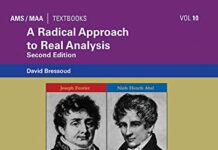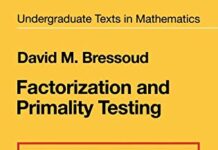
Ebook Info
- Published: 2008
- Number of pages: 344 pages
- Format: PDF
- File Size: 25.89 MB
- Authors: David M. Bressoud
Description
This lively introduction to measure theory and Lebesgue integration is motivated by the historical questions that led to its development. The author stresses the original purpose of the definitions and theorems, highlighting the difficulties mathematicians encountered as these ideas were refined. The story begins with Riemann’s definition of the integral, and then follows the efforts of those who wrestled with the difficulties inherent in it, until Lebesgue finally broke with Riemann’s definition. With his new way of understanding integration, Lebesgue opened the door to fresh and productive approaches to the previously intractable problems of analysis.
User’s Reviews
Editorial Reviews: Review “Bressoud is an insightful writer, and he presents this material in an enchanting fashion. The writing is scholarly but inviting, rigorous but readable. There are heaps of exercises, and they are quite accessible. I know of no other source with such a wealth of information about the genesis of the modern integral concept. This book will be valuable for mathematicians, for scholars of mathematical history, and certainly for students.” Steven G. Krantz, American Institute of Mathematics for The UMAP Journal”A new and noteworthy title from Cambridge University Press! An outstanding book meant to advance undergraduate and beginning graduate students in mathematics.” B. Crstici, Mathematical Reviews”I find it difficult to think of a better introduction to this corner store of modern mathematics and highly recommend the book to a very broad readership of students and researchers alike.” Paul Embrechts, ETH Zurich for the Journal of the American Statistical Association Book Description An introduction to measure theory and Lebesgue integration rooted in the historical questions that led to its development.
Reviews from Amazon users which were colected at the time this book was published on the website:
⭐Bressoud brings the interested reader a different introduction to Lebesgue’s theory motivated by the questions that couldn’t be naturally answered in their historical context. Typically when first learning Lebesgue’s theory it is either at the end of a real analysis text or abstractly in a measure theory course. It is rarely motivated by the historical problems it was first developed to help answer. This book goes the other way around and discusses the build up to the Lebesgue theory by looking at the motivating problems, largely around the convergence of functions.A Radical Approach toe Lebesgue’s Theory of Integration starts by describing the world as content with Riemann’s integration theory; the author reminds the reader of Darbou’x criteria for integrability and then highlights how functions were thought of in the 19th century. When I first was taking a class on measure theory I recall the textbook using Dirichlet’s function where f(x) is 1 if rational and 0 otherwise as not being integrable but the author highlights these are not the kinds of mappings really considered functions and Fourier convergence motivated more advancements in integration theory than things like the Dirichlet function. The author introduces set theory and cardinality and discusses the cardinality of sigma algebras and topologies, ideas i had not seen before elsewhere. The author spends a lot of time on Cantor-Volterra functions as they are ideal candidates to understand the subtle issues on convergence and measure. The author then introduces the early concepts that eventually led to mature measure theory. Namely Borel and Jordan’s concepts of measure which was then followed by the concept of outer measure. The author has a nice construction of a non-measurable set following Vitali. The author then develops Lebesgue measure on the real line and proves the monotone/dominated convergence theorems and discusses Lusin and Egorov’s theorems as well, helping the reader to understand that pathologies of functions can be restricted to arbitrarily small sets. The author then revisits Fourier series and convergence and discusses some elementary functional analysis.All in all this is a nice textbook to get historical context for the evolution of real analysis leading to measure theory. The book has hints to exercises so can be used for self-study easily. I don’t think it is a great textbook or should be used for a course as it is a bit impractical to generalize results from and long winded as a reference. I am glad I got it and think it helps read modern treatments of measure theory as it motivates the subject matter when it could otherwise be overly dry.
⭐The history of integration theory is a tortuous path of subtle nuances in our understanding of how to generalise apparently simple concepts. Most students go through life without understanding the turmoil that was going on at the foundations of the edifice. David Bressoud is well known for a number of books but this one is a real tour de force. This is a very difficult conceptual area and what he has done is to link the historical development to a rigorous analytical context. This helicopter view of the sweep of history is one of the hardest things for a student to obtain. Bressoud has done a magnificent job in pulling all the strands together in a way which could be understood by a student who has made a serious study of analysis. There are many examples which walk you through important foundational results eg Darboux’s proof that a certain function was continuous everywhere but differentiable nowhere. The exercises are supplemented by some hints but I think for such a difficult area it would be a good idea to have a website with full solutions or perhaps a separate problem based book.Analytic concepts such as continuity, compactness, uniform convergence, closed and open sets etc all figure in their historical context and Bressoud demonstrates from the historical record why, for instance, Riemann integration was supplanted by Lebesgue integration (at least at the theoretical level). Notwithstanding that Lebesgue theory is over a century old it is still not usually taught at undergraduate level. It is generally extremely poorly explained even though it is absolutely fundamental to the techniques of modern finance theory.Very simply Bressoud takes you on a journey that seeks to explain why Lebesgue integration theory holds sway at the theoretical level. Along the way you get to meet your old friends: Riemann, Bolzano, Weierstrass, Borel, Heine, Cantor etc etc .Books such as this provide invaluable insights for those who really want to understand the subject. The pieces do fall together and one’s understanding of the subject is enriched.Brilliant!
⭐If you had calculus in high school or college then you learned about Newton, Leibnitz, and Riemann but probably did not encounter Lebesgue (pronounced le-bek). At the University of Alabama Huntsville learning about Lebesgue integration is key to advancing into graduate studies in mathematics.I purchased this book, after reading about it in the Mathematical Association of America (MAA). For autodidacts like myself, it is a good first introduction to the topic.
⭐My review is limited to what I have read so far as I am currently going through this book. Although I am a graduate student in mathematics I felt that I still had not fully grasped the whole Riemann integration – Lebesgue integration stuff so I bought this book. I am not disappointed. As I am reading and working through the book, I am finding my understanding of stuff that I already knew enhanced. I think this is a supplementary book for those who have studied the theory elsewhere but want to enrich their understanding.
⭐This is an utterly useless book!I bought it.Read it.This book does not contain anything new that is not contained in any other book on Measure Theory. The title of this book contains “Radical Approach”. There is nothing “radical here”.All the contents are standard bromide. No clarity is added.Besides, this book contains plenty of mathematical errors.
⭐I like this look at the subject
⭐David Bressoud führt den Leser anhand der historischen Erkenntnisse der Maßtheorie/Integrationstheorie an die Erkenntnisse der modernen Theorie heran. Dabei sieht auch der erfahrene/wissende Leser viele Dinge aus anderem, neuen Blickwinkel und es sind dank der sorgfältig ausgewählten Beispiel und Gegenbeispiele viele Aha-Erlebnisse dabei.Für mich, der das Thema im Studium vor 45 Jahren für sich erobert hatte, ein aufregendes Buch. Immer noch!Wirklich ein Empfehlung. Hinweis: Nur für Mathematiker, die die Vorlesungen Analysis I und II gut verstanden haben! Sonst sinnlos.A very gentle intro to the topic, motivated by historical developments and limitations of existing tools which the necessity of a new definition of the integral coming natural into play. A very good textbook for an intro course but if you want an advanced textbook on the topic, you might be slightly disappointed.
Keywords
Free Download A Radical Approach to Lebesgue’s Theory of Integration (Mathematical Association of America Textbooks) in PDF format
A Radical Approach to Lebesgue’s Theory of Integration (Mathematical Association of America Textbooks) PDF Free Download
Download A Radical Approach to Lebesgue’s Theory of Integration (Mathematical Association of America Textbooks) 2008 PDF Free
A Radical Approach to Lebesgue’s Theory of Integration (Mathematical Association of America Textbooks) 2008 PDF Free Download
Download A Radical Approach to Lebesgue’s Theory of Integration (Mathematical Association of America Textbooks) PDF
Free Download Ebook A Radical Approach to Lebesgue’s Theory of Integration (Mathematical Association of America Textbooks)


